Clan MacLeod of Lewis facts for kids
The MacLeod Clan of Lewis, also known as Clan MacLeod of The Lewes (Scottish Gaelic: Clann Mhic Leòid Leòdhais), is a Highland Scottish clan. At its strongest, this clan owned large areas of land in the Western Isles and on the west coast of Scotland. From the 1300s to the early 1600s, there were two main groups of MacLeods. One group was the MacLeods of Dunvegan and Harris (Clan MacLeod). The other group was the MacLeods of the Isle of Lewis. In Gaelic, the MacLeods of Lewis were called Sìol Thorcaill ("Seed of Torquil"). The MacLeods of Dunvegan and Harris were known as Sìol Thormoid ("Seed of Tormod").
The MacLeods traditionally believe their family started with a man named Leod. An old story, which is not widely accepted now, said he was the son of Olaf the Black, who was the King of Mann and the Isles. A more accepted story says his father was Olvir, and the clan was called Sliochd Olbhur. Leod was said to have two sons. One was Tormod, who started the MacLeods of Harris and Dunvegan (Sìol Thormoid). The other was Torquil, who started the MacLeods of Lewis (Sìol Thorcaill). In the 1500s and early 1600s, the main family line of the MacLeod Clan of Lewis almost ended. This was due to many family fights, especially involving a powerful chief known as "Old Rory" and his children. These conflicts led to the clan's decline and the loss of their lands to the Clan Mackenzie. However, one part of the family, the MacLeods of Raasay, survived and did well on their lands for many years. The current chief of Lewis comes from this surviving family.
Today, the MacLeod Clan of Lewis, the MacLeod Clan of Raasay, and Clan MacLeod work together. They are part of the "Associated Clan MacLeod Societies." This group includes ten national societies around the world. These are in Australia, Canada, England, France, Germany, New Zealand, Scotland, South Africa, Switzerland, and the United States of America.
Contents
The Clan's Beginnings
Stories About Olaf the Black
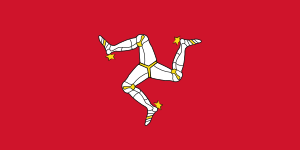
The official clan story today says that the MacLeods came from Leod, who was born around the year 1200. Traditionally, the MacLeods of Harris and Dunvegan believe they are descendants of Leod's son Tormod. The MacLeods of Lewis believe they are descendants of Leod's other son, Torquil. The first proof of this link to Olaf the Black might only be from the 1600s. A document from 1630 called Iain Mor MacLeod (who was chief of Clan MacLeod from 1626 to 1649) "John McOlaus of Dunvegane." Also, his son Iain Breac (chief from 1664 to 1693) was likely the first MacLeod to use the coat of arms of the Kings of Mann in his own. This was because "the MacLeods imagined themselves descended from King Olaf of Man."
Leod, who the clan is named after, does not appear in old records. He is not even in the Chronicles of Mann, which lists Olaf's four sons. After the last king of this family, Magnus Olafsson, died in 1265, and the last known male family member left the Isle of Mann in 1275, the claims to the Isle of Mann went to the family's daughters. This suggests that the male family line from Olaf the Black had ended. So, there is no real historical reason to believe Leod was Olaf the Black's son.
Clan Lands and the Nicolsons
Recently, some historians have found a link between the early MacLeod clan and the Nicolsons/MacNicols from the Hebrides. Historians W.D.H. Sellar and William Matheson noted that in lands held by the MacLeods (Lewis, Wester Ross, and Waternish on the Isle of Skye), there were stories of the Nicolsons/MacNicols being there first. For Lewis itself, the story was that the MacLeods got the island by marrying a Nicolson heiress. Both Sellar and Matheson agreed that this traditional link and getting land through the Nicolsons explains why the MacLeods of Lewis were seen as a separate clan from the MacLeods of Harris and Dunvegan.
Also, even though the heraldry (family symbols) of the MacLeod of The Lewes is very different from that of the MacLeod of MacLeod, there might be a connection to the Hebridean Nicolsons/MacNicols. In their coat of arms, the MacLeods of The Lewes have "a black burning mountain on a gold field." Sellar suggested that when the MacLeods married the Nicolson heiress, her family symbols would likely have passed to the MacLeods. The Hebridean Nicolsons/MacNicols were believed to have held their lands in the Western Isles from the Norse rulers. They got these lands for their work as coast-watchers. This might explain the burning mountain on the MacLeod of The Lewes's coat of arms.
Clan History
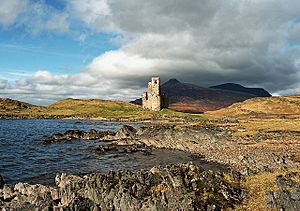
The 1300s and 1400s
The first mention of the MacLeods of Lewis is in a royal document from the time of David II King of Scots (who ruled from 1329 to 1371). This document shows that Torcall MacLeod was given the land of Assynt, possibly around 1343. In this document, Torcall had no special title, which means he did not own property before then. By 1344, the MacLeods of Lewis held the Isle of Lewis. They were loyal to the Macdonalds of Islay. Over time, the MacLeods of Lewis became very powerful. They even became rivals to the MacLeods of Harris. Their lands stretched from the islands of Lewis and Raasay to the area of Waternish on Skye. On the mainland, they owned Assynt, Coigach, and Gairloch.
In 1406, a group of MacLeods of Lewis lost a battle called the battle of Tuiteam Tarbhach against a group of Mackays. The story says the battle happened because Sidheag, the widow of Angus Mackay of Strathnaver, was treated badly by her brother-in-law Hucheon. Sidheag was also the sister of The MacLeod of The Lewes. So, a group of MacLeods of Lewis, led by the chief's brother, Gille-caluim Beag, met a group of Mackays in Sutherland. In the battle, the MacLeods were defeated, and Gille-caluim Beag was killed.
The 1500s
In 1528, John MacLeod of The Lewes, who was the clan chief, helped his half-brother, Donald Gruamach MacDonald of Sleat. Donald had taken the lands of Trotternish from the MacLeods of Harris and Dunvegan.
Domhnall Dubh was declared Lord of the Isles by many families who had once served under Clan Donald. These included the MacLeods of Lewis, the Camerons of Locheil, the MacLeans of Duart, the MacLeans of Lochbuie, and the MacQuarries of Ulva. Also, the MacNeills of Barra and the MacDonalds of Largie supported him. The only families who stayed loyal to the King were the MacLeods of Harris and Dunvegan, and the MacIains of Ardnamurchan. When the rebellion ended and Domhnall Dubh died in 1545, Ruairi was forgiven for his part in the uprising. But he and his clan clearly continued to act on their own, without following the Scottish Government. In 1554, special orders were given to remove Ruairi MacLeod of The Lewes, John Moydertach of Clan Ranald, and Donald Gormson MacDonald of Sleat. This happened after they all refused to attend a meeting in Inverness.
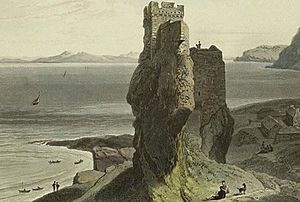
The Clan's Decline
The clan's decline and the loss of the Isle of Lewis began with Ruairi. He married a daughter of John Mackenzie of Kintail. They had a son named Torquil Connanach. Ruairi's wife later left him and went with his cousin, John MacGillechallum of Raasay. After this, Ruairi divorced her. In 1541, Ruairi married Barbara Stewart and had a son named Torquil Oighre ("Heir").
Around 1566, Torquil Oighre drowned with sixty of his supporters while sailing from Lewis to Skye. Immediately, Torquil Connanach, who had been disowned, started a conflict. He was supported by the Mackenzies. He captured his father, Ruairi, and kept him prisoner for four years in Stornoway Castle.
Ruairi was only set free when he agreed to accept Torquil Connanach as his rightful heir. In 1572, Ruairi was brought before the Privy Council. He was forced to give his lands of Lewis, Assynt, Coigach, and Waternish to the Crown. These lands were then given to Torquil Connanach as his heir. Ruairi only got them back to use during his lifetime. When Ruairi returned to Lewis, he said he would not follow what he had agreed to. He claimed he had been forced. Later, in 1576, Regent Morton helped Ruairi and Torquil Connanach make peace. Torquil was again made the rightful heir and also received land in Coigach.
Some time later, Ruairi married for a third time. He married a daughter of Hector Og Maclean of Duart. They had two sons, Torquil Dubh and Tormod. Ruairi also had several sons born outside of marriage, including Tormod Uigach and Murdoch. Ruairi then made Torquil Dubh his heir. Again, Torquil Connanach started a conflict, supported by the Mackenzies. Ruairi was helped by some of his sons, including Donald, Ruairi Og, and Niall. However, two others, Tormod Uigach and Murdoch, helped Torquil Connanach. In the fight that followed, Ruairi was captured again, and many of his men were killed. After Torquil Connanach's victory, all the land documents for Lewis were given to the Mackenzies. Ruairi was held prisoner in Stornoway Castle, which was controlled by Torquil Connanach's son, John. But Ruairi was freed when Ruairi Og attacked the castle and killed John. After his release, Ruairi ruled Lewis peacefully for the rest of his life.
When Ruairi MacLeod of The Lewes died, Torquil Dubh became the clan chief. In 1596, Torquil Dubh, with 700 or 800 men, damaged Torquil Connanach's lands of Coigach and the Mackenzie lands of Loch Broom. Because of this, Torquil Dubh was called to appear before the Privy Council. He was declared a rebel when he did not show up. Torquil Dubh was finally betrayed by the Brieve of Lewis, who was the chief of the Morrisons of Ness. Once captured, the brieve sent Torquil Dubh to Coigach. There, he and his friends were beheaded by Torquil Connanach, following orders from Kenneth Mackenzie of Kintail, in July 1597. After this, Lewis was controlled by Torquil Dubh's three young sons and his brother Niall. The MacLeods of Lewis were also helped by the MacLeods of Harris and the Macleans.
Losing Lewis
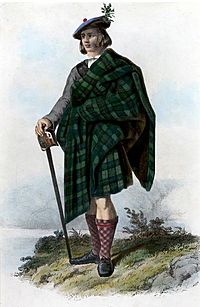
Even though Torquil Dubh had several sons, Donald Gorm Mor of Sleat thought he should be the heir of the dead chief of Lewis. He invaded the island to claim it. After causing much damage, the MacDonald of Sleat chief was driven off the island by the people of Lewis. Because the Mackenzies now had the legal documents for Lewis, the island was taken by the government in 1597. This gave the Scottish Government a reason to try to settle the island with new people.
During this time on Lewis, the MacLeods were involved in many conflicts with their neighboring clans, like the Morrisons and their enemies, the MacAulays of Lewis.
The End of Old Ruairi’s Family Line
After the Mackenzies took control of Lewis, Niall MacLeod and his nephews Malcolm, William, and Ruairi (the sons of Ruairi Og), along with about thirty others, found safety on Bearasay. This island is at the mouth of Loch Roag on the west coast of Lewis. For almost three years, the small group of MacLeods fought against the Mackenzies before being forced out. Niall then gave himself up to Ruairi Mor MacLeod of Harris and Dunvegan. Later, when traveling in the south, Ruairi had to give Niall and Niall's son Donald to the Privy Council in Edinburgh. Ruairi Mor later spent some time in prison for helping the rebels. However, he was also later made a knight for his service to the King. Niall was put on trial, found guilty, and executed in April 1613. He died "very Christianlie." Niall's son Donald was sent away from Scotland and died in Holland without any known children.
Two of Ruairi Og's sons, Ruairi and William, were captured and hanged by Mackenzie of Kintail. The one remaining son, Malcolm, was captured at the same time. But he escaped and bothered the Mackenzies for years afterward. Malcolm played a big part in Sir James Macdonald's rebellion in 1615. Later, he went to Flanders. In 1616, he was back on Lewis, where he killed "two gentlemen of the Mackenzies." Later, he went to Spain. He returned in 1620 with Sir James Macdonald. Orders were given to Lord Kintail and the Mackenzies to take action against "Malcolm MacRuari MacLeod" in 1622 and 1626. Nothing more is known about him. Tormod, the last son of Old Ruairi, was released from prison in Edinburgh in 1615. He left for Holland, where he died with no known children. Nothing is known about what happened to Torquil Dubh's sons, Ruairi and Torquil.
After the MacLeods lost control of Lewis, the title Lord MacLeod became the second title of the Mackenzie, Earls of Cromartie. They claimed this right because they were descended from Margaret, Torquil Conanach's daughter, who inherited her father's claim to Lewis. Over time, the leadership of the MacLeods of Lewis passed to the MacLeods of Raasay, who were close relatives of Old Ruairi. This line of chiefs continues to this day.
The 1900s and 2000s
Torquil Roderick MacLeod, the 17th of Raasay, was a farmer who lived in Tasmania. He was interested in the clan's history. In 1988, he was officially recognized as "Torquil Roderick MacLeod of The Lewes and Chief and Head of the baronial House of MacLeod of The Lewes" by the Lord Lyon King of Arms. In 2001, the clan chief died. His oldest son, Torquil Donald MacLeod of The Lewes, took his place. The current chief of the MacLeod Clan of Lewis lives in Sandy Bay, Tasmania, Australia.
Today, both the MacLeod Clan of Lewis and Clan MacLeod are part of the "Associated Clan MacLeod Societies" (ACM). The chiefs are Hugh Magnus MacLeod of MacLeod, Chief of Clan MacLeod, and Torquil Donald MacLeod of The Lewes, Chief of the MacLeod Clan of Lewis. The group has nine national societies around the world. These are in Australia, Canada, England, France, Germany, New Zealand, Scotland, South Africa, Switzerland, and the United States of America. The ACM last held a big meeting in 2006 on the Isle of Lewis.
MacLeod DNA Study
A recent study looked at the DNA of MacLeod men. It found that almost half of 45 men with the surname (47%) were related to the same ancestor. This genetic marker is rare in the British Isles. It has been found in "MacLeod territory" as well as in Orkney, Shetland, and Norway. The study suggests this is proof that the clan's founder had Norse (Viking) origins.
Clan Details
Meaning of the Name
The clan surnames MacLeod and McLeod are English versions of the Gaelic name Mac Leòid. This means "son of Leòd." The Gaelic name (Leòd) comes from the Old Norse name Ljótr. This name can mean "bright" or "shining," or sometimes "ugly."
Clan Chiefs
| # | Name | Dates | Family Notes |
|---|---|---|---|
| 1 | Torquil Og | before 1320. | |
| 2 | Roderick (Ruaidhri) Mor | around 1362. | |
| 3 | Torquil | around 1394–after 1498. | |
| 4 | Roderick (Ruaidhri) | around 1426–after 1496. | |
| 5 | Torquil | around 1450–before 1511. | |
| 6 | Roderick ("Old Ruari") | around 1500–around 1595. | |
| The main chief line was lost. A new line is recognized today. | |||
| Torquil Roderick | 1919–2001. | He was recognized as MacLeod of Raasay. In 1988, the Lord Lyon recognized him as Roderick MacLeod of the Lewes and Chief of the MacLeod of The Lewes family. | |
| Torquil Donald | born 1948. | He is the current chief. He is the oldest son of Torquil Roderick. | |
Clan Branches
- The MacLeods of Raasay come from Gillicallum (Malcolm) MacLeod. He was the second son of the Laird of Lewis. He lived in the mid to late 1400s and married Marion, daughter of John Gorm Campbell. In 1597, John Macgillichallum, who was the brother of the Laird of Raasay, was killed at the Battle of Logiebride. The current chief of the MacLeods of Raasay is Roderick John MacLeod, the 18th of Raasay. He lives in Tasmania, Australia. He is the brother of the current MacLeod of The Lewes.
- The MacLeods of Assynt
- In the early 1400s, Roderick MacLeod of The Lewes gave the lands of Assynt to his younger son, Tormod. This Tormod became the ancestor of the MacLeods of Assynt. In the 1500s, the MacLeods of Assynt supported the Mackays of Aberach, a part of the Clan Mackay. They helped in a conflict against their chief Huistean Du Mackay, 13th of Strathnaver. During this conflict, the MacLeods of Assynt fought against the Clan Gunn at the Battle of Leckmelm in 1586. However, the MacLeods of Assynt later sided with Huistean Du Mackay of Strathnaver in a conflict against the Earl of Caithness. During the civil war of the 1600s, after the Battle of Carbisdale on April 27, 1650, where the Royalists were defeated, James Graham, 1st Marquess of Montrose was given shelter by the wife of Neil MacLeod of Assynt at Ardvreck Castle. She then handed him over to the Marquess of Argyll. Neil was the last MacLeod chief to own lands in Assynt. In 1672, he was declared a rebel, and his lands were taken by the Seaforth Mackenzies. During the Jacobite rising of 1745, the MacLeods of Lewis supported the Jacobite side. However, Hugh MacLeod of Geanies led a group of MacLeods of Assynt to support the British Government.
- The MacLeods of Pabbay and Uig
- This branch of the clan, called the MacLeods of Pabbay and Uig, comes from Norman (Old Norman) MacLeod. He was born around 1480 and was a son of Torquil MacLeod, who was the 6th Chief of the MacLeods of Lewis. Old Norman owned lands at Hacklete, Earshader, Pabbay, and Baille na Cille. Members of this branch often spell their name with a small 'l'. Many church ministers and doctors have come from this family branch.
Clan Castles
Castles that belonged to the MacLeod Clan of Lewis include:
- Stornoway Castle, Stornoway, Isle of Lewis. This castle was also known as MacLeod's Castle. The MacLeods of Lewis held it. An older fort on the same spot, possibly from the 1000s, was held by the Clan MacNicol. The MacLeods might have forced the MacNicols from Lewis, or married a MacNicol heiress by force, or both. The Clan Gordon Earl of Huntly captured the castle in 1506. But it managed to hold out against the Clan Campbell Earl of Argyll in 1554. Oliver Cromwell's forces destroyed it in 1653. Cromwell's forces were then reportedly attacked by the islanders.
- Brochel Castle, a small and ruined fort, seven miles north of Clachan on Raasay. This was held by the MacLeod of Raasay branch of the clan.
- Assynt Castle, also known as Eilean Assynt, four miles north-west of Inchnadamph on the mainland. It was built on an island on Loch Assynt, but little remains today. The MacLeod of Assynt branch of the clan held it. The Clan Mackay of Strathnaver attacked it in 1585, and the Clan Mackenzie attacked it in 1646. The castle might have been used as a prison after the clan moved to Ardvreck Castle.
- Ardvreck Castle was a later home for the MacLeod of Assynt branch of the clan. The Mackenzies attacked it in 1672.
- Geanies Castle, near Tain, Ross. The MacLeod of Geanies branch of the clan held it. But it passed to the Clan Sinclair in 1624.
- See also: Castles of the Clan MacLeod.
Clan Septs
Clan septs are families who were protected by a stronger clan. Scottish clans were often made up of different families, whether they were actually related or not. These families were loyal to one chief. For example, in the area of Dunvegan in 1746, out of 500 men, only 110 were actually MacLeods. All of these men rented land from the MacLeod chief and would have acted as part of the clan. The following names are considered septs of the MacLeod Clan of Lewis.
| Names | Notes |
|---|---|
| Allum, Callam, Callum, Challum, Gillecallum, MacAllum, MacAlman MacCallum, MacCalman, MacGillechallum, Malcolm. Malcolmson. | These names are also linked to Clan MacCallum and Clan Malcolm. According to George Fraser Black, Mac-ille-Challum is the family name of the MacLeods of Raasay. |
| Lewis. | This name is also linked to Clan Stewart. |
| MacAskill, Kasky, MacAsgill, MacCaskie, Caskie, MacCaskill, MacKaskill, McCaskill, MaKasky, Taskill. | The name MacAskill means son of Askell. Askell is a Norse personal name. The MacAskills lived on the Isle of Skye and held Dunscaith Castle in the 1300s. William MacAskill led the MacLeods in battle against the MacDonalds in the 1500s. During the Jacobite rising of 1745, Clan MacLeod supported the British Government. John MacAskill was an Ensign in one of the special Highland Companies raised by the MacLeod chief to help the government. Calgary Castle on the Isle of Mull was built for the MacAskills around 1823. The city of Calgary in Canada gets its name from this castle. |
| MacAulay, Aulay, Calley, Caulay, Coll, MacAllay, MacAlley, MacAuley, MacCaulay, MacCauley, MacCorley. | See Macaulays of Lewis. According to James Ayars, a coordinator for the Associated Clan MacLeod Society, "MacAuley is a sept of both Clan MacLeod and Clan Donald, and also a clan on its own," see Clan MacAulay. |
| MacCabe, MacKabe. | According to Black, McCabe is a branch of the MacLeods of Arran who moved to Ireland in the 1300s. |
| MacCorkill, MacCorkindale, MacCorkle, MacCorquodale MacKerkyll, MacKorkyll, MacOrkill, McCorkie, McKurkull. | These names are also linked to Clan Gunn. See also Clan McCorquodale. |
| MacCorkindale, Corquodale and MacCorcadail, MacCorkill, MacCorkle, MacCorquodale, MacThorcadail. | Black also lists Corquodale. However, there is no proof of any link between MacCorkindale and its related names and MacLeod. See also, Clan McCorquodale. |
| Nicol, deNicole, MacNichol, MacNickle, McNychol, Necolson, Nichol(s), Nicholl, Nicholson, Nickle, Nicoll, Nicollsoun, Nicolson, Nuccol, Nuckall, Nucolsone. | Nicol is also linked to Clan Macfie. There is also a Clan Nicolson and Clan MacNeacail. |
| Norie, Noray, Nore, Norn, Norrey, Norreys, Norrie, Norris, Norye. | |
| Tolmie. | Black wrote that the Tolmies of the Hebrides are called Clann Talvaich. |
Clan Symbols
Crest Badge
- Crest badge:
- Chief's crest: A golden sun shining brightly.
- Chief's motto: There are two versions of the chief's motto.
- I birn quil I se. This is often wrongly translated as, "I shine, not burn." The correct meaning is, "I burn, while I watch."
- Luceo non uro. (translation from Latin: "I burn but am not consumed," or "I shine, not burn.")
- The mottoes refer to the coat of arms of MacLeod of The Lewes. This coat of arms shows a burning beacon or a fiery mountain. This symbol might have originally belonged to the MacNicol coast-watchers.
Tartan
| Tartan image | Notes |
|---|---|
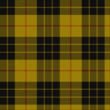 |
This tartan is sometimes called "Loud MacLeod." It is generally known as "MacLeod Dress" or "MacLeod of Lewis." Sometimes it is called "Macleod, Yellow of Raasay." It is one of the most easily recognized Scottish tartans. The first picture of this pattern, thought to be from the 1830s, is a portrait of John MacLeod, the 13th of Raasay. There is even a sample, dated 1822, with a note saying "invented by MacLeod of Raasay." Sir Thomas Dick Lauder, in a letter to Sir Walter Scott in 1829, described it as: "MacLeod (of Dunvegan) has got a sketch of this splendid tartan, three black stryps upon ain yellow fylde." It is thought that the MacLeod chief was a good friend of the Sobieski Stuarts. They gave him a sketch of the tartan years before they published it as "Clann-Lewid" in the Vestiarium Scoticum in 1842. The Vestiarium was a Victorian hoax made by the fake 'Sobieski Stuarts'. It is the source for many of today's "clan tartans." |
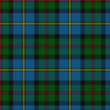 |
This tartan is sometimes called "MacLeod hunting" or "MacLeod of Harris." It was shown in several early collections of tartan, like Logan's The Scottish Gael (1831) and Smibert's (1851). The tartan comes from the Mackenzie tartan used by John Mackenzie in 1771. He used it when he formed the regiment known as "Lord MacLeod's Highlanders." The Mackenzies claimed to be the heirs to the chiefship of the MacLeods of Lewis after Roderick died in 1595. Norman Magnus, the 26th chief of the Dunvegan MacLeods, approved this tartan. The clan society adopted it in 1910. |
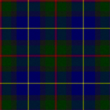 |
"MacLeod of Assynt." The MacLeods of Assynt are a branch of the MacLeod Clan of Lewis. This tartan looks almost the same as the "MacLeod of Harris/Hunting" tartan (shown above). It was first published as "MacLeod of Assynt" in 1906. |
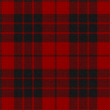 |
The "MacLeod of Raasay" tartan is very similar to the MacLeod tartan found in the Vestiarium (shown at the top). It is thought to be based on that pattern. So, it is believed to be from sometime after 1829. However, its inclusion in the records of the Highland Society of London might mean it is older. In this other idea, the yellow "Vestiarium" tartan would have come from the older Raasay pattern. |

